
Abu Simbel Temple: A Journey to the Heart of Ancient Egyptian Civilization
The Abu Simbel Temple is an ancient Egyptian temple in Nubia, near the border between Egypt and Sudan. It is one of Egypt’s most famous and well-preserved temples, with stunning architecture and intricate carvings. This blog post will examine the Abu Simbel Temple and explore its history, significance, and cultural importance.
History of Abu Simbel Temple
The Abu Simbel Temple was built during the reign of Pharaoh Ramesses II, around 1264 BC. The temple was constructed to honor the gods Amun, Ra-Horakhty, and Ptah and to commemorate Ramesses II’s victory at the Battle of Kadesh.
The temple was initially located on the banks of the Nile River, but it was relocated in the 1960s to avoid being submerged by the rising waters of the Aswan High Dam. The temple relocation was a massive undertaking that involved cutting the temple into pieces and reassembling it in a new location.
The architecture of Abu Simbel Temple
The Abu Simbel Temple is known for its stunning architecture and intricate carvings. The temple is carved into a solid rock cliff and features two massive statues of Ramesses II at the entrance. The temple’s interior is decorated with hieroglyphics and relief sculptures depicting various Egyptian mythology and history scenes.
One of the Temple’s most significant features is its statue alignment. The temple is designed so that twice a year, on February 22 and October 22, the sun’s rays penetrate the temple’s inner sanctuary and illuminate the statues of Ramesses II, Ptah, and Amun.
Significance of Abu Simbel Temple
The Abu Simbel Temple is significant for several reasons. Firstly, it is one of Egypt’s most famous and well-preserved temples, with stunning architecture and intricate carvings. It is also essential for its religious importance. The temple was dedicated to the gods Amun, Ra-Horakhty, and Ptah, who were worshipped as the creators of the universe and the protectors of the pharaohs.
The temple is also significant for its cultural importance. The temple’s architecture reflects the blending of Egyptian and Nubian styles and is considered a symbol of the close relationship between the two cultures.
Visiting Abu Simbel Temple
The Abu Simbel Temple is open to visitors daily and is a popular tourist destination in Egypt. Visitors can reach the temple by plane, located in a remote area of Nubia. They can explore the temple’s chambers, courtyards, and hypostyle halls. They can also see the remains of the ancient processional avenue, which was once used for religious processions.
Visitors can also learn about the history and construction of the temple at the nearby Abu Simbel Visitors Center. The center features exhibit on the temple’s history and a collection of artifacts discovered during the temple’s relocation.
Conclusion
The Abu Simbel Temple is a breathtaking destination that offers a glimpse into the heart of ancient Egyptian civilization. Its stunning architecture, intricate carvings, and religious significance make it a must-visit destination for anyone interested in history and archaeology. If you plan a trip to Egypt, include the Abu Simbel Temple on your itinerary. It is a journey back in time that you will never forget.
- July 6, 2023
- 646
- Aswan Attractions
- 0 comment
